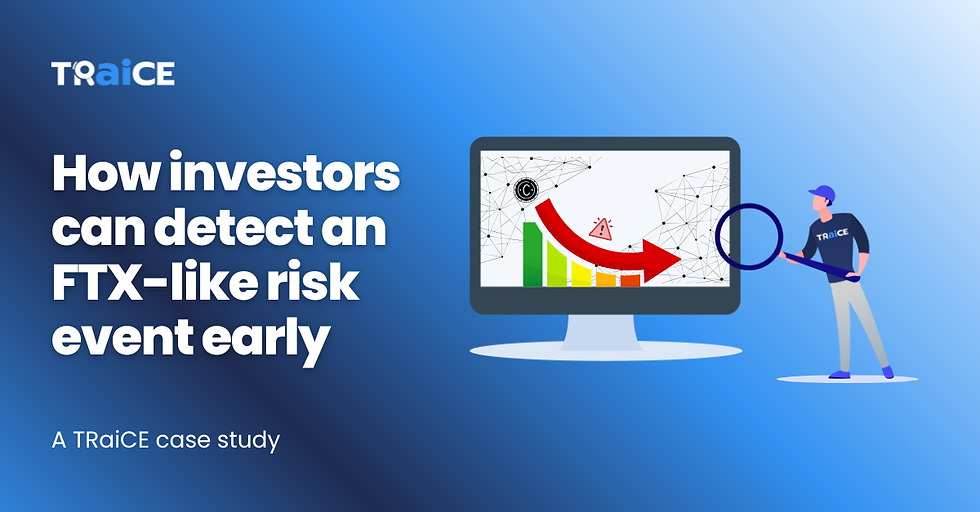The SunPower Bankruptcy and the importance of Early Warning Signals in managing risks – a TRaiCE case study
- Betsy Jacob
- Aug 20, 2024
- 4 min read
Earlier this month, SunPower Corporation, a trail-blazing American solar energy provider, declared bankruptcy. From a credit risk management perspective, the fall of this one-time industry pioneer did not come without early warning signs. Some of these forewarnings were hidden while others were not so much. This blog delves into what these were and how uncovering such signs in real time is a 21st-century imperative for corporate lenders and investors.

The SunPower Bankruptcy
Founded in 1985 by Richard Swanson, SunPower was the leading solar panel manufacturer in the United States for years. At one point in its nearly 40-year history, the company was valued at $10 billion and held a world record for solar-cell efficiency. It had a successful IPO in 2005, acquired several rival solar companies, and spearheaded large-scale solar installations nationwide.
So, what went wrong? Combine some bad luck and bad business choices, then throw in some financial impropriety and customer complaints and you have a recipe for SunPower’s financial struggles and loss of investor confidence. Key issues included supply chain disruptions that affected production and delivery schedules, increased competition in the solar energy market, rising interest rates, changes in government incentives that drove down margins, and difficulties in scaling up its high-efficiency solar panel technology.
Additionally, strategic missteps, such as project delays, over-reliance on certain markets, an insistence on maintaining premium prices, and an underdeveloped customer service team further compounded these challenges. Whispers of accounting fraud followed by noncompliance notices from the SEC and Nasdaq were the final straws that broke the company’s back leading to its bankruptcy filing on August 5, 2024.
Were there Early Warning Signs of default?
While a bankruptcy event draws global attention due to its dramatic nature and impact, it is usually foreshadowed by a series of smaller, less noticeable setbacks that often slip past a risk manager’s radar. These lesser-known issues serve as Early Warning Signals of trouble ahead. Real-time early risk indicators (or leading risk indicators) can be found by examining unstructured digital data. For a more detailed look at these, check out our blog on 5 leading indicators every lender and investor should monitor.
Like Pink Energy, another solar company that collapsed in late 2022, SunPower too had its fair share of red flags. In fact, an article hinting at a potential SunPower bankruptcy emerged in September 2016, eight years before the event unfolded. The article called attention to the company’s debt pile and its ability to erase or refinance it. More tellingly, SunPower received a noticeable share of complaints and negative reviews in recent years. Some of these complaints date back to 2020. A majority of them complained about the company’s poor customer service and uncompetitive pricing.
SunPower has also seen a significant number of shakeups. In December of 2019, the company slashed its workforce by 3%. SunPower's former CEO, Tom Werner, resigned in 2021 and was succeeded by Peter Faricy who in turn departed the company in Feb 2024. In 2022, the company replaced its CFO and, in late 2023, announced the resignation of both its Executive Vice President of Financial Products and Corporate Controller. The company’s accountant also resigned amid escalating concerns about its accounting practices and internal controls after it admitted that there were misstatements in its 2022 fiscal filing. Investors have also filed several class action lawsuits against the solar company during this time.
All in all, SunPower has had a tumultuous few years with clear early signs of corporate instability.
What the TRaiCE Business Sentiment Index showed
The TRaiCE platform monitors online unstructured data, continuously gathering information on the companies it reviews. This data is then organized and analyzed to generate a digital risk score, reflecting each company's level of risk. This score forms the foundation of the TRaiCE Business Sentiment Index (BSI).
As the graph below shows SunPower’s BSI score dropped from 16 to 5 in February 2022, a significant drop of 11 points. The drop was influenced by events such as a class-action lawsuit charging the company with violations of the Securities Exchange Act and other negative coverage. The company's scores experienced similar drops in April and June of 2022, reflecting the rising number of complaints and negative reviews it received on the Better Business Bureau website, Yelp, and other review sites.

These complaints became so numerous that the company's score dropped into negative territory in September 2022 and stayed at moderate-risk levels for a few months thereafter (circled in red). Of note, these warning signs were signaled nearly 2 years before the company collapsed. Various events such as stock price volatility, more class action lawsuits, and negative media around the company meant it had low-risk scores midway through 2023 onwards. By then, the writing was on the wall for the solar company.
Conclusion
Access to real-time Early Warning Signals, as described above, enables risk managers to identify event patterns that can eventually lead to potential defaults and bankruptcies. At TRaiCE, we integrate this data into predictive models to provide financiers with valuable insights that can guide their decision-making and help them mitigate risks before they can impact the bottom line.
Want to know more? Reach out to us at info@traice.io or schedule a demo with us today for a free walkthrough of our platform.











Comments